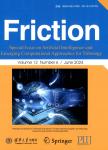Water-based superlubricity in vacuum
Water-based superlubricity in vacuum作者机构:Tribology Research InstituteState Key Laboratory of Traction PowerSouthwest Jiaotong University State Key Laboratory of TribologyTsinghua University Beijing Key Laboratory of Long-life Technology of Precise Rotation and Transmission MechanismsBeijing Institute of Control Engineering
出 版 物:《Friction》 (摩擦(英文版))
年 卷 期:2019年第7卷第2期
页 面:192-198页
核心收录:
学科分类:0817[工学-化学工程与技术] 08[工学] 0805[工学-材料科学与工程(可授工学、理学学位)] 0802[工学-机械工程] 0801[工学-力学(可授工学、理学学位)]
基 金:financial support from the National Natural Science Foundation of China (Nos.51527901,51405256) Self-developed Project of State Key Laboratory of Traction Power (No.2017TPL_Z02)
主 题:friction water-based superlubricity vacuum phosphoric acid
摘 要:This study achieved water‐based superlubricity with the lubrication of H_3PO_4 solution in vacuum(highest vacuum degree 10–4 torr) for the first time by performing a pre‐running process in air before running in vacuum. The stable water‐based superlubricity was sustainable in vacuum(0.02 torr) for 14 h until the test was stopped by the user for non‐experimental factor. A further analysis suggested that the superlubricity may be attributed to the phosphoric acid–water network formed in air, which can efficiently lock water molecules in the liquid lubricating film even in vacuum owing to the strong hydrogen bond interaction. Such capability to lock water is strongly affected by the strength of hydrogen bond and environmental conditions. The realization of water‐based superlubricity with H_3PO_4 solution in vacuum can lead to its application in space environment.



